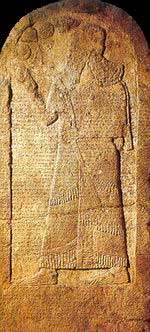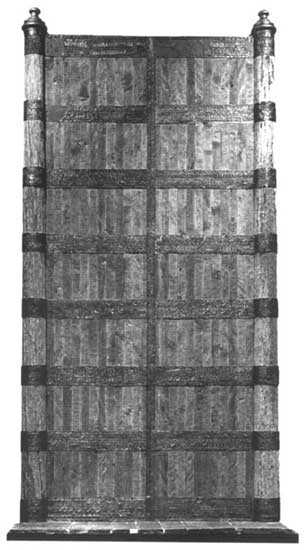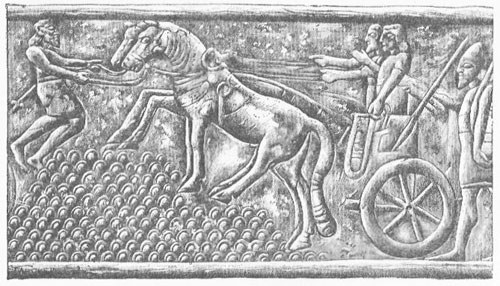1599 Geneva Bible (GNV)
The Geneva Bible: A Cornerstone of English Protestantism A Testament to Reform The 1599 Geneva Bible... Read More
"Shalmaneser, the great king, strong king, king of the world, king of Assyria, son of Ashurnasirpal, the great king, strong king, king of the world, king of Assyria, son of Tukulti-Ninurta, king of the world, king of Assyria, construction of the ziggurat of Kalhu," -Shalmaneser III Inscription

Shalmaneser III Stele which records the Qarqar battle.
Shalmaneser III came to the throne of Assyria in 859 BC and reigned until 824 BC. He was the son of the mighty conqueror Ashurnasirpal II and the first Assyrian king to go to war with Israel.
In fact his nearly 35 year reign was filled with almost continual warfare in the north and to the west (Syria-Israel), as recorded on stele’s, statues, and cuneiform tablets of clay and stone…which record 34 war campaigns.
In 853 BC he attacked Syria and Israel at Qarqar, and it was at this time that king Ahab of Israel allied with the Syrians, Arabs, Egyptians and Phoenicians to oppose Shalmaneser at the banks of the Tigris River.
The alliance of 11 kings was led by king Hadad-ezer of Damascus and Irhuleni of Hamath. Shalmaneser claimed victory in his Monolith Inscription having put “25,000 men to the sword.”
He also claimed that the opposing army was 63,000 men strong and mentions the very name of Ahab of Israel who provided 10,000 foot soldiers and 2,000 chariots. Shalmaneser left the area and did not return for another 8 years, in 845 BC he came with a massive army of 115,000 men and defeated the king of Damascus at Mount Hermon.

Shalmaneser's massive wooden Gates of Balawat (858-824 BC) held together by their detailed bronze bands inform us of his methods of waging war and the bloodshed involved in his campaigns. The bands contain 16 registers total (with two continuous battle narratives on each band), scenes of Shalmaneser's campaigns were carved into 10.6 inch bronze strips which were then nailed to the wooden palace gates.

In the above statue of Shalmaneser III he is holding a mace which is a symbol of kingship. He also holds a curved club, with two daggers under his belt. In an archaic sort of way his robe is similar to that of Ashurnasirpal II. Notice the symbols of his most important Assyrian deities (Adad, Shamash, Ishtar and Sin) which are placed around his neck. The lower half of the statue is covered with inscriptions which mention his mighty deeds, and also record the building of the town wall of Ashur.
In 841 BC many kings brought great tribute to Shalmaneser to show their submissiveness, including the kings of Tyre, Sidon, and Jehu, the king of Israel. In fact the first to pay tribute were the kings of Israel and Judah. The Black Obelisk of Shalmaneser shows king Jehu groveling in the dust before king Shalmaneser.

This stela depicts Shalmaneser III holding a mace and pointing a finger (in a gesture of respect or reverence) towards the symbols of his principal deities.
From 839-828 BC Shalmaneser wreaked havoc in northwest Syria and in 835 BC he carved his name and image into a giant cliff beside a river called the Dog River, north of Beirut, Lebanon. He also records some of his mighty exploits during this time on the Balawat Gates.

Shalmaneser in his war chariot crossing the mountains
No king of Assyria left more royal inscriptions and annals than Shalmaneser III. The Black Obelisk of Shalmaneser shows king Jehu of Israel offering tribute to Shalmaneser III in 841 BC. Shalmaneser made campaigns to the west, north and south, even plundering Babylon.
Shalmaneser’s capital was Nimrud (ancient Kalhu). His buildings were numerous, he built a huge walls, gates including Balawat, a great Ziggurat, temples and a huge fortress named Fort Shalmaneser by the excavators.
Shalmaneser III also mentions Jehu on another fragment from his annals:
"In the 18th year of my reign I crossed the Euphrates for the sixteenth time. Hazael of Damascus trusted in the power of his forces, marshalled his troops in full strength. He made Senir (Mt. Hermon), the summit of the mountain opposite Lebanon, his stronghold. With him I fought, and defeated him. Six thousand of his soldiers I brought down with weapons; 1121 of his chariots, 470 of his horses, together with his camp, I took from him. To save his life he fled; I pursued him; in Damascus, his royal city, I shut him up. His plantations I destroyed. As far as the mountains of Hauran I marched. Towns without number I laid waste, razed, and burnt with fire. There innumerable spoil I carried away. As far as to the mountains of Baal-rasi situated close to the sea (the head land at Dog River), I marched. My royal image I set up in that place. At that time I received the tribute of the Tyrians and Sidonians, and of Jehu the son of Omri." - Shalmaneser III
Read Full Text on the Black Obelisk
Also see: Assyrian History
The Geneva Bible: A Cornerstone of English Protestantism A Testament to Reform The 1599 Geneva Bible... Read More
The 21st Century King James Version (KJ21): A Modern Approach to a Classic Text A Balancing Act The ... Read More
The American Standard Version (ASV): A Cornerstone of Modern English Bibles A Product of Scholarly R... Read More
The Amplified Bible (AMP): A Rich and Comprehensive Translation The Amplified Bible (AMP) stands out... Read More
The Amplified Bible, Classic Edition (AMPC): A Timeless Treasure The Amplified Bible, Classic Editio... Read More
The Authorized (King James) Version (AKJV): A Timeless Classic The Authorized King James Version (AK... Read More
The BRG Bible: A Colorful Approach to Scripture A Unique Visual Experience The BRG Bible, an acronym... Read More
The Christian Standard Bible (CSB): A Balance of Accuracy and Readability The Christian Standard Bib... Read More
The Common English Bible (CEB): A Translation for Everyone The Common English Bible (CEB) is a conte... Read More
The Complete Jewish Bible (CJB): A Jewish Perspective on Scripture The Complete Jewish Bible (CJB) i... Read More
The Contemporary English Version (CEV): A Bible for Everyone The Contemporary English Version (CEV),... Read More
The Darby Translation: A Literal Approach to Scripture The Darby Translation, often referred to as t... Read More
The Disciples' Literal New Testament (DLNT): A Window into the Apostolic Mind The Disciples’ Literal... Read More
The Douay-Rheims 1899 American Edition (DRA): A Cornerstone of English Catholicism The Douay-Rheims ... Read More
The Easy-to-Read Version (ERV): A Bible for Everyone The Easy-to-Read Version (ERV) is a modern Engl... Read More
The English Standard Version (ESV): A Modern Classic The English Standard Version (ESV) is a contemp... Read More
The English Standard Version Anglicised (ESVUK): A British Accent on Scripture The English Standard ... Read More
The Evangelical Heritage Version (EHV): A Lutheran Perspective The Evangelical Heritage Version (EHV... Read More
The Expanded Bible (EXB): A Study Bible in Text Form The Expanded Bible (EXB) is a unique translatio... Read More
GOD'S WORD Translation (GW): A Modern Approach to Scripture The GOD'S WORD Translation (GW) is a con... Read More
The Good News Translation (GNT): A Bible for Everyone The Good News Translation (GNT), formerly know... Read More
The Holman Christian Standard Bible (HCSB): A Balance of Accuracy and Readability The Holman Christi... Read More
The International Children's Bible (ICB): A Gateway to Faith The International Children's Bible (ICB... Read More
The International Standard Version (ISV): A Modern Approach to Scripture The International Standard ... Read More
The J.B. Phillips New Testament: A Modern Classic The J.B. Phillips New Testament, often referred to... Read More
The Jubilee Bible 2000 (JUB): A Unique Approach to Translation The Jubilee Bible 2000 (JUB) is a dis... Read More
The King James Version (KJV): A Timeless Classic The King James Version (KJV), also known as the Aut... Read More
The Lexham English Bible (LEB): A Transparent Approach to Translation The Lexham English Bible (LEB)... Read More
The Living Bible (TLB): A Paraphrase for Modern Readers The Living Bible (TLB) is a unique rendering... Read More
The Modern English Version (MEV): A Contemporary Take on Tradition The Modern English Version (MEV) ... Read More
The Mounce Reverse Interlinear New Testament: A Bridge to the Greek The Mounce Reverse Interlinear N... Read More
The Names of God Bible (NOG): A Unique Approach to Scripture The Names of God Bible (NOG) is a disti... Read More
The New American Bible, Revised Edition (NABRE): A Cornerstone of English Catholicism The New Americ... Read More
The New American Standard Bible (NASB): A Cornerstone of Literal Translations The New American Stand... Read More
The New American Standard Bible 1995 (NASB1995): A Refined Classic The New American Standard Bible 1... Read More
The New Catholic Bible (NCB): A Modern Translation for a New Generation The New Catholic Bible (NCB)... Read More
The New Century Version (NCV): A Bible for Everyone The New Century Version (NCV) is an English tran... Read More
The New English Translation (NET): A Transparent Approach to Scripture The New English Translation (... Read More
The New International Reader's Version (NIRV): A Bible for Everyone The New International Reader's V... Read More
The New International Version - UK (NIVUK): A British Accent on Scripture The New International Vers... Read More
The New International Version (NIV): A Modern Classic The New International Version (NIV) is one of ... Read More
The New King James Version (NKJV): A Modern Update of a Classic The New King James Version (NKJV) is... Read More
The New Life Version (NLV): A Bible for All The New Life Version (NLV) is a unique English translati... Read More
The New Living Translation (NLT): A Modern Approach to Scripture The New Living Translation (NLT) is... Read More
The New Matthew Bible (NMB): A Reformation Revival The New Matthew Bible (NMB) is a unique project t... Read More
The New Revised Standard Version (NRSV): A Modern Classic The New Revised Standard Version (NRSV) is... Read More
The New Revised Standard Version Catholic Edition (NRSVCE): A Cornerstone of Modern Catholicism The ... Read More
The New Revised Standard Version, Anglicised (NRSVA): A British Accent on Scripture The New Revised ... Read More
The New Revised Standard Version, Anglicised Catholic Edition (NRSVACE): A Bridge Between Tradition ... Read More
The New Testament for Everyone (NTE): A Fresh Perspective The New Testament for Everyone (NTE) is a ... Read More
The Orthodox Jewish Bible (OJB): A Unique Perspective The Orthodox Jewish Bible (OJB) is a distincti... Read More
The Revised Geneva Translation (RGT): A Return to the Roots The Revised Geneva Translation (RGT) is ... Read More
The Revised Standard Version (RSV): A Cornerstone of Modern English Bibles The Revised Standard Vers... Read More
The Revised Standard Version Catholic Edition (RSVCE): A Cornerstone of English Catholicism The Revi... Read More
The Message (MSG): A Contemporary Paraphrase The Message, often abbreviated as MSG, is a contemporar... Read More
The Voice: A Fresh Perspective on Scripture The Voice is a contemporary English translation of the B... Read More
The Tree of Life Version (TLV): A Messianic Jewish Perspective The Tree of Life Version (TLV) is a u... Read More
The World English Bible (WEB): A Modern Update on a Classic The World English Bible (WEB) is a conte... Read More
The Worldwide English (WE) New Testament: A Modern Take on a Classic The Worldwide English (WE) New ... Read More
The Wycliffe Bible: A Cornerstone of English Scripture A Revolutionary Translation The Wycliffe Bibl... Read More
Young's Literal Translation (YLT): A Literal Approach to Scripture Young's Literal Translation (YLT)... Read More
For enthusiastic readers, managing a collection of books can become challenging. An expanding "to be... Read More
Deuteronomy 18 - "And if you say in your heart, 'How shall we know the word which the LORD has not ... Read More
John 14:26 - "But the Counselor, the Holy Spirit, whom the Father will send in my name, he will teac... Read More
(Enlarge) (PDF for Print) Map of the Origin of Nations and Races that were dispersed by God in Gene... Read More
The Journeys of Abraham (Enlarge) (PDF for Print) - Map of Abraham's Journey with Trade Routes Map ... Read More
(Enlarge) (PDF for Print) Map of the Route of the Hebrews from Egypt This map shows the Exodus of t... Read More
Mark 6:52 - For they considered not the miracle of the loaves: for their heart was hardened. God did... Read More
also see:The Encampment of the Children of IsraelThe Children of Israel on the March THE OUTER COURT... Read More
2 Chronicles 36:23 - Thus saith Cyrus king of Persia, All the kingdoms of the earth hath the LORD Go... Read More
All Bible Maps - Complete and growing list of Bible History Online Bible Maps. Old Testament Maps T... Read More
The Bible portrays marriage as a lifelong bond built on love, faith, and commitment, reflecting God'... Read More
Ancient Manners and Customs, Daily Life, Cultures, Bible Lands NINEVEH was the famous capital of an... Read More
Distances From Jerusalem to: Bethany - 2 milesBethlehem - 6 milesBethphage - 1 mileCaesarea - 57 m... Read More
Dagon was the god of the Philistines. This image shows that the idol was represented in the combina... Read More
Map of Israel in the Time of Jesus (Enlarge) (PDF for Print) Map of First Century Israel with Roads... Read More
The Table of Shewbread (Ex 25:23-30) It was also called the Table of the Presence. Now we will pas... Read More
see also:The PriestThe Consecration of the PriestsThe Priestly Garments The Priestly Garments 'The ... Read More
Introduction to the Book of Daniel in the Bible Daniel 6:15-16 - Then these men assembled unto the k... Read More
The Golden Lampstand was hammered from one piece of gold. Exod 25:31-40 "You shall also make a lam... Read More
The Golden Altar of Incense (Ex 30:1-10) The Golden Altar of Incense was 2 cubits tall.It was 1 cub... Read More
Ancient Tax Collector Illustration of a Tax Collector collecting taxes Tax collectors were very des... Read More
also see: Blood Atonement and The Priests The Five Levitical Offerings The Sacrifices The sacrificia... Read More
Genesis 10:32 - These are the families of the sons of Noah, after their generations, in their nation... Read More
Illustration of Jesus Reading from the Book of Isaiah This sketch contains a colored illustration o... Read More
"But the angel said unto him, Fear not, Zacharias: for thy prayer is heard; and thy wife Elisabeth s... Read More
also see: The Encampment of the Children of IsraelThe Children of Israel on the March The brazen a... Read More
In a rapidly evolving world shaped by both timeless values and groundbreaking technology, individual... Read More
Rome, the Eternal City, has stood as a symbol of history, culture, and religion for over two millenn... Read More
Many teachers assign pieces titled “an essay about god in my life.” The title invites calm thought a... Read More
Exploring identity has become part of the digital life. Social media, streaming, and gaming give you... Read More
Unearth the rich tapestry of biblical history with our extensive collection of over 1000 meticulously curated Bible Maps and Images. Enhance your understanding of scripture and embark on a journey through the lands and events of the Bible.
Start Your Journey Today!
